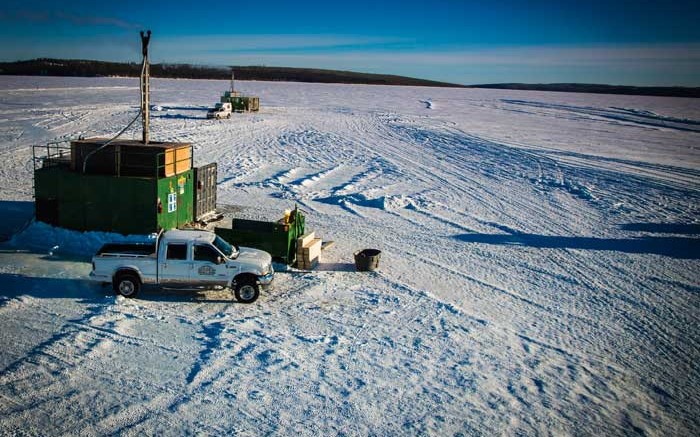VANCOUVER — Thirty-six holes into a 90-hole winter program, the five drill rigs at Fission Uranium’s (TSXV: FCU; US-OTC: FCUUF) Patterson Lake South (PLS) project are batting 100% in their hunt for mineralization between the known uranium zones.
The market has taken notice, boosting Fission shares 63% so far in 2014 to $1.71. Analysts following the story think the climb will continue, with target prices that predict a 40% gain or more.
There are reasons for the optimism. The uranium Fission has discovered at PLS is high grade and sits at an unconformity that starts 50 to 60 metres below surface. High-grade, open-pittable uranium deposits are unusual and desirable.
And Fission seems to have figured out how to reach the uranium at PLS, hitting mineralization in every one of the 36 holes it has drilled this year.
Last year Fission’s two drill programs at PLS totalled 21,000 metres and outlined seven mineralization zones along a 1.8 km trend. This year the company is drilling 30,000 metres in its current program alone, mostly aimed at connecting the zones.
This goal is already being realized. In three sets of scintillometer results released over four trading days, Fission joined zones 780E and 945E and extended the new, joined zone along strike and across its width with two high-grade hits.
Two holes joined the zones: hole 146 cut 99.5 metres of mineralization in a 269-metre section, including 7.4 metres of off-scale radioactivity, while hole 153 returned 73.5 metres of mineralization in a 149-metre section.
Fission is calling the area zone 780E, and it’s working on an extension.
At the eastern end of the zone hole 158 cut 86 metres of mineralization in a 205-metre section, including 10.9 metres of off-scale radioactivity. The hit suggests that the system “is not letting up to the east towards the under-tested 1155E zone,” Raymond James analyst David Sadowski writes in a note.
A few days later hole 164 returned the second-strongest scintillometer result from the property to date: 136 metres of mineralization, including 30 metres of off-scale radioactivity. The only intercept from PLS better than that came from hole 129, which cut 367 metres of off-scale radioactivity and later assayed at 38.5 metres grading 13.66% uranium oxide.
Hole 164 widened zone 780E by 10 metres, to 40 metres.
Zone 780E and its neighbour, zone 1155E, make up the eastern third of the mineralized trend at PLS. In the middle of the trend, two new hits just shortened the gap between zones 390E and 595E to just 60 metres.
The first hit came in hole 160, which returned 85.5 metres of mineralization in a 191.5-metre section, including 16.2 metres of off-scale radioactivity. The second came from hole 165, which cut 59 metres of mineralization.
“This bolsters the potential of similar continuity throughout the 1.78 km trend,” Sadowski wrote. “We believe it is likely that additional drilling this winter will similarly fill in gaps between 390E, 595E and 780E.”
Fission president and chief operating officer Ross McElroy agrees.
“The winter program at PLS continues to deliver a 100% hit rate as we progress towards showing our multiple high-grade zones are all part of a single large zone,” McElroy said. “The evidence is mounting that we are dealing with a mineralized system of substantial size.”
Mick Carew, analyst with Haywood Securities, echoed the sentiment.
“This represents the second set of results in three days . . . where scout drilling along the electromagnetic conductor has reduced the gap between previously defined uranium mineralized zones,” Carew wrote. “These results indicate that significant radioactive zones are present in areas containing relatively low uranium anomalism from water and radon-soil surveys. This provides support to the suggestion that . . . PLS could represent one continuous mineralized zone.”
If Fission can connect all seven PLS zones, the mineralization body would strike for 1.8 km. Widths range from 20 to 95 metres, though Sadowski notes the zones are width-limited by a lack of drill holes, not because drills failed to find mineralization.
News of the latest results from PLS added 28¢ to Fission’s share price over three days, bringing it to $1.71. At the start of 2014, shares were worth $1. The company listed in April 2013 at 57¢. Fission has 329 million shares outstanding.


Be the first to comment on "Every hole a hit as Fission joins zones at PLS"